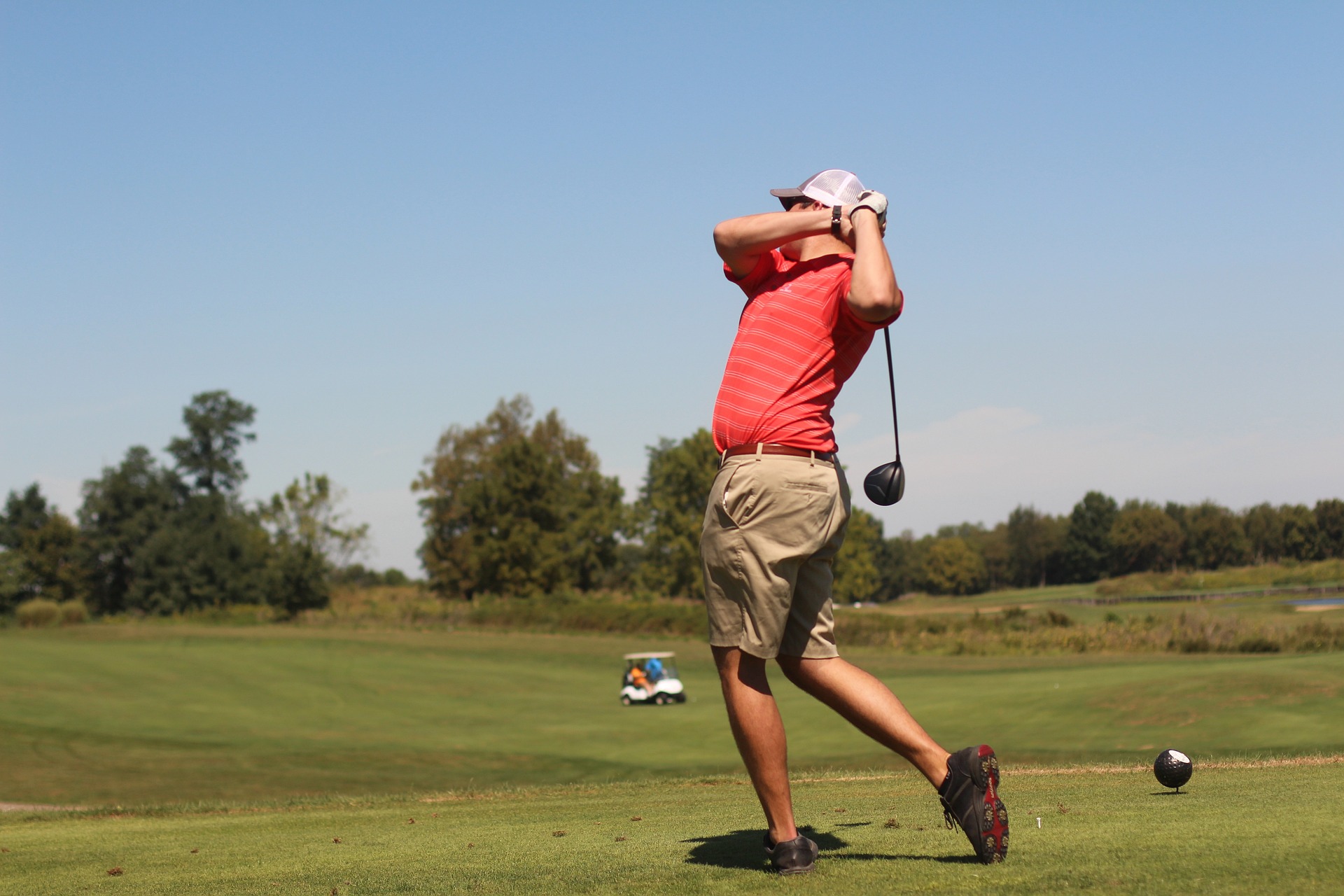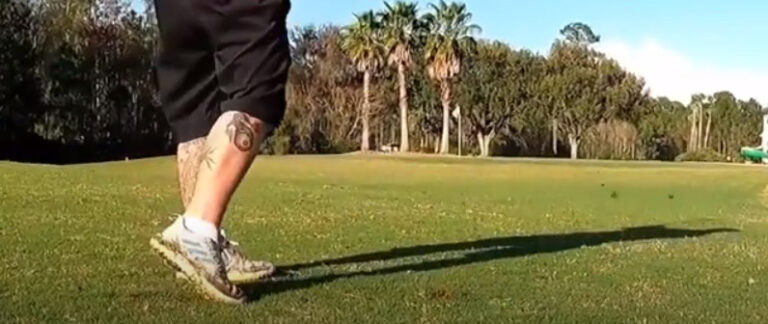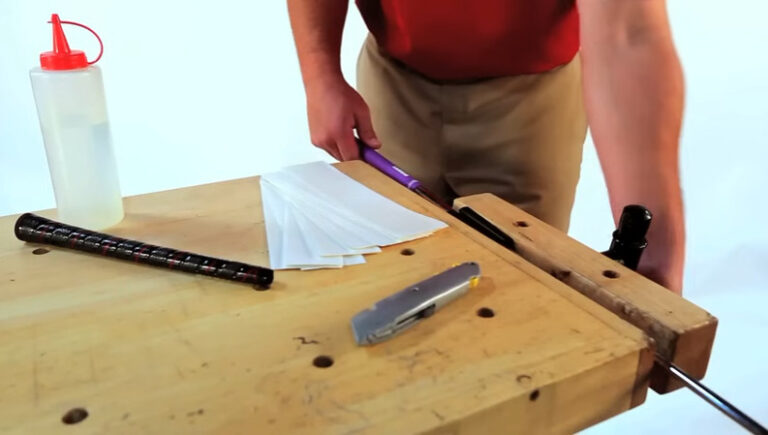How to perfect your golf swing.
Hi folks, it’s tee time again and to help get better, I am going to share insights into how to perfect your golf swing.
You all know that Golf is a game of skill, patience, and technique. One of the most critical aspects of the game is the golf swing. A perfect golf swing is the key to hitting the ball with accuracy and distance.
Earlier, I shared some incredible insights into breaking 90, you might want to check it out Here if you are struggling with breaking 90.
In this article, I’ll break down the fundamentals of a golf swing and provide helpful tips and techniques to help you perfect your swing. So grab your clubs and let’s get started!
The Fundamentals of a Golf Swing.
Before diving into the intricacies of perfecting your golf swing, it’s essential to understand the basics.
Grip:
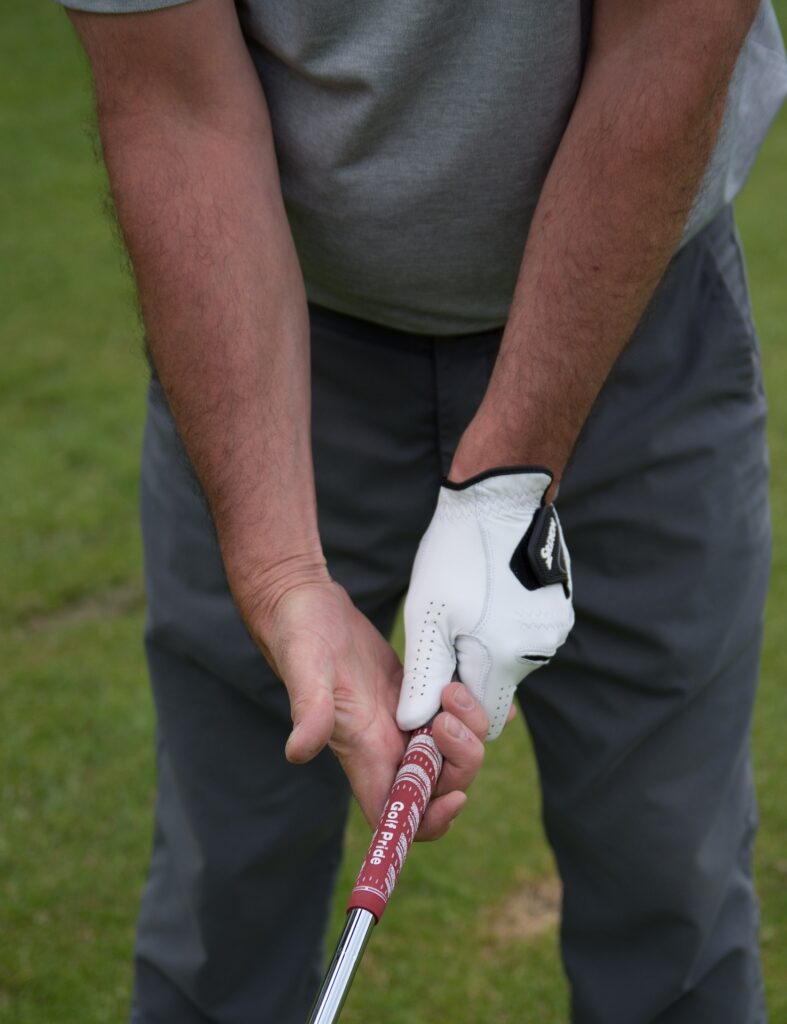
The grip is an essential aspect of your golf swing, as it’s the only connection between you and the club. A proper grip ensures better control, accuracy, and power in your swing.
Here’s a brief overview of the three main types of golf grips and some tips for achieving a proper grip.
Three Main Types of Golf Grips:
Interlocking Grip: The interlocking grip is popular among golfers with small hands or those who have difficulty maintaining a firm grip on the club. To achieve this grip, interlock the pinky finger of your trailing hand (right hand for right-handed golfers, left hand for left-handed golfers) with the index finger of your leading hand.
Overlapping Grip: Also known as the Vardon grip, the overlapping grip is the most common grip among professional golfers. To use this grip, place the pinky finger of your trailing hand on top of the crease between the index and middle fingers of your leading hand.
Baseball Grip: The baseball grip, or ten-finger grip, is often recommended for beginners, golfers with limited hand strength, or those with joint issues. To use this grip, place all ten fingers on the club, with the pinky finger of your trailing hand touching the index finger of your leading hand.
Tips for Achieving a Proper Golf Grip:
Grip Pressure: Grip the club firmly but not too tightly. A grip that’s too tight can restrict your swing and lead to a loss of control. Aim for a grip pressure similar to holding a tube of toothpaste without squeezing any out.
Hand Position: Ensure that the heel pad of your leading hand is positioned on top of the club grip, with the fingers wrapped securely around the handle. This provides a solid foundation for your grip and prevents the club from slipping during your swing.
Alignment: The “V” shapes formed by your thumb and index finger on both hands should be pointing towards your trailing shoulder. This alignment promotes proper wrist hinge and clubface control throughout your swing.
Now that you have a better understanding of the different types of golf grips and focus on proper grip pressure, hand position, and alignment, you’ll be well on your way to a more controlled and accurate golf swing.
Stance:
Your stance is a crucial element of your golf swing, as it sets the foundation for balance, stability, and power. A proper stance allows for efficient weight transfer and body rotation during the swing. Here are some key tips for achieving the optimal golf stance.
Tips for an Optimal Golf Stance:
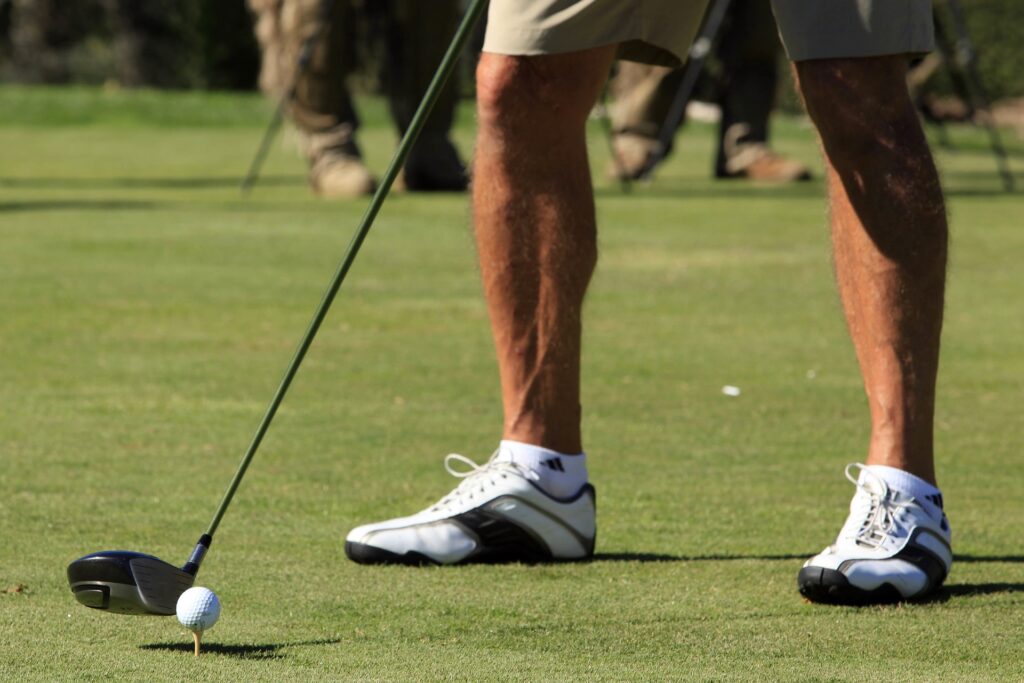
Foot Position: Begin by positioning your feet shoulder-width apart. This width provides a stable base for your swing while allowing for sufficient weight transfer and rotation. If you’re using a longer club (such as a driver), you can widen your stance slightly to accommodate the longer arc of the swing.
Foot Alignment: Your toes should point slightly outward, about 5 to 10 degrees. This positioning promotes better hip rotation during your swing and helps maintain balance throughout the motion. Avoid aligning your feet parallel to the target line, as this can restrict your hip rotation and lead to an inconsistent swing.
Weight Distribution: Distribute your weight evenly between your feet, with a slight favoring of the balls of your feet. This distribution helps maintain balance during your swing and allows for efficient weight transfer throughout the motion. Avoid leaning too heavily on your heels or toes, as this can lead to instability and inconsistent shots.
Knee Flex: Slightly bend your knees to create a more athletic and ready position. This flex helps absorb the force generated during your swing and promotes better weight transfer and body rotation. Be careful not to bend your knees too much, as this can lead to an overly crouched position and restrict your movement.
Ball Position: The position of the ball in your stance varies depending on the club you’re using. For shorter clubs (like wedges), place the ball in the middle of your stance. As the club length increases, gradually move the ball forward in your stance, with the ball positioned near your front heel for the driver.
By focusing on foot position, alignment, weight distribution, knee flex, and ball position, you can create a stable and balanced stance that sets the foundation for a powerful and accurate golf swin
Posture:
Good posture is essential for a consistent and powerful golf swing. It allows for proper body rotation, weight transfer, and club movement throughout the swing. Here are some key tips to help you achieve and maintain the ideal golf posture.
Tips for Proper Golf Posture:
Spine AngleStart by standing tall, with your feet shoulder-width apart. Then, bend forward from your hips while maintaining a straight back. Your spine should form an angle of approximately 45 degrees with the ground. This angle enables a more natural and efficient swing motion.
Arm PositionLet your arms hang comfortably down from your shoulders. Your hands should be positioned just below your waist, with your arms hanging straight down but not locked. This relaxed arm position allows for a more fluid swing and reduces tension in your upper body.
Chin PositionKeep your chin up, allowing for a clear view of the ball. Tucking your chin into your chest can restrict your shoulder rotation during the swing, leading to inconsistent shots. Maintain a comfortable distance between your chin and your chest throughout the swing.
Back StraightnessIt’s crucial to maintain a straight back while bending at the hips. A hunched or rounded back can cause a variety of swing issues, including poor rotation, loss of power, and inconsistent ball striking. Focus on engaging your core muscles and keeping your back straight throughout your swing.
Knee FlexAs mentioned earlier in the stance section, maintain a slight bend in your knees to create an athletic and ready position. This flex helps absorb the force generated during your swing and promotes better weight transfer and body rotation.
By concentrating on your spine angle, arm position, chin position, back straightness, and knee flex, you can establish a proper golf posture that sets the foundation for an effective and consistent swing.
Perfecting the Golf Swing.
Now that you’ve mastered the fundamentals, it’s time to focus on perfecting your swing. The golf swing can be broken down into six main components:
Takeaway:
Initiate your backswing with a smooth and controlled movement, keeping the clubface square to the ball as long as possible. Avoid jerking the club or moving too quickly, as this can lead to an off-plane swing and inconsistent results.
Backswing:
Rotate your shoulders and hips while maintaining your spine angle, allowing the club to move along the correct swing plane. Keep your left arm (for right-handed golfers) straight and maintain the wrist hinge throughout the backswing.
Transition:
As you reach the top of your backswing, begin the transition to the downswing by shifting your weight from your back foot to your front foot. This weight transfer helps generate power and creates the proper swing sequence.
Downswing:
Keep your head steady and your eyes focused on the ball as you swing the club downward. Unhinge your wrists and rotate your hips and shoulders to generate power and maintain the proper swing plane. It’s crucial to avoid the “over-the-top” move, where the club moves outside the ideal swing plane, leading to slices and pulls.
Impact:
At the point of impact, your hips should be open, and your weight should be primarily on your front foot. Your hands should be slightly ahead of the clubhead, creating a forward shaft lean that promotes solid contact and better ball-striking.
Follow-Through:
Continue to rotate your hips and shoulders as you complete your swing, with your weight finishing on your front foot. Your chest should face the target, and your arms should be fully extended. A balanced and controlled follow-through helps ensure a smooth and consistent swing.
Common Golf Swing Mistakes.

Even experienced golfers can fall victim to common swing mistakes. Here are three of the most prevalent issues and how to correct them:
Over swinging:
Swinging too hard can lead to a loss of control and accuracy. Focus on maintaining a smooth, controlled swing with a consistent tempo.
Incorrect Weight Shift:
Failing to transfer your weight properly during the swing can reduce power and accuracy. Concentrate on shifting your weight smoothly from your back foot to your front foot throughout the swing.
Poor Timing:
Rushing your swing can lead to mistimed shots and inconsistent results. Practice maintaining a steady rhythm and tempo throughout your swing.
Golf Swing Training Aids.
There are numerous training aids available to help you perfect your golf swing. Some popular options include swing analyzers, weighted clubs, and alignment sticks. Don’t be afraid to experiment with different training aids to find the one that works best for you.
Practice Makes Perfect.
As with any skill, practice is the key to perfecting your golf swing. Dedicate time to practicing your swing, focusing on each component individually before putting them all together. Remember, even the pros are continually working on their swings, so be patient and persistent.
Additional Golf Swing Tips.
In addition to the advice provided above, here are a few more tips to help you perfect your golf swing:
Visualize Success:
Visualization is a powerful tool that can help you improve your golf swing. Before each swing, take a moment to visualize the perfect shot, from the initial takeaway to the follow-through. This mental rehearsal can help reinforce good habits and boost your confidence on the course.
Stay Relaxed:
Tension in your muscles can negatively impact your swing. Focus on staying relaxed throughout your swing, particularly in your grip, arms, and shoulders. A relaxed swing allows for a more fluid motion, which can lead to increased power and accuracy.
Record Your Swing:
Filming your swing can be an invaluable resource in identifying areas for improvement. Analyze the footage to spot any inconsistencies or issues in your technique. Share the video with a golf instructor or knowledgeable friend for additional feedback.
Work on Your Short Game:
While perfecting your golf swing is essential, don’t neglect your short game. Mastering your chipping and putting skills can help you shave strokes off your score and make you a more well-rounded golfer.
Stay Patient:
Remember that golf is a challenging game that takes time and effort to master. Stay patient, and don’t get discouraged if progress seems slow. Keep practicing, learning from your mistakes, and celebrating your successes along the way.
The Importance of Customizing Your Approach.
No two golfers are alike, which means that there is no one-size-fits-all approach to perfecting your golf swing.
Experiment with different techniques and tips to discover what works best for you. Be open to making adjustments and customizing your swing to suit your unique strengths, weaknesses, and preferences.
By combining the advice in this article with a personalized approach, you’ll be well on your way to perfecting your golf swing and enjoying greater success on the course. Keep practicing, stay dedicated, and remember to have fun along the way!
FAQs.
Here are some of the most frequently asked questions on perfecting golf swings and our expert answers.
How long does it take to perfect a golf swing?
There’s no definitive timeline for perfecting a golf swing, as it varies from person to person. It requires consistent practice and dedication to see improvement.
Are there specific exercises that can help improve my golf swing?
Yes, exercises targeting core strength, flexibility, and balance can help improve your golf swing. Yoga, Pilates, and resistance training are all excellent options.
How important is club fitting to perfecting my golf swing?
Club fitting is crucial because it ensures your clubs are tailored to your swing style, body type, and skill level. Properly fitted clubs can enhance your swing and improve your overall game.
Can a golf pro help me perfect my swing?
Absolutely! A golf pro can analyze your swing, identify areas for improvement, and provide personalized coaching and drills to help you make progress.
How often should I practice my golf swing to see improvement?
Ideally, you should practice your golf swing several times a week. The more consistent and focused your practice, the faster you’ll see improvement.
Conclusion.
Perfecting your golf swing is a journey that requires patience, practice, and attention to detail. By understanding the fundamentals, focusing on each component of the swing, and avoiding common mistakes, you can make significant improvements in your game.
Don’t forget to practice regularly and consider using training aids to help you fine-tune your swing even further. Now, hit the course and start perfecting your golf swing!

